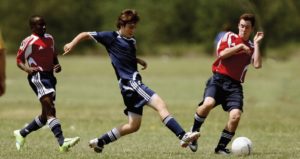By League of Education Voters Policy Team
We believe students come first. We are focused first and foremost on meeting the needs of every student.
We are dedicated to designing an equitable education system that serves all students based on their strengths, supports their needs, and provides the resources they need to be successful.
We are committed to working to close gaps experienced by historically and systemically underserved students— including students of color, students in poverty, students qualifying for special education services, students learning English, and students impacted by trauma. We believe this will lead to all students experiencing greater success and reaching their full potential.
WHY WE SUPPORT EXPANDED LEARNING OPPORTUNITIES
 Expanded learning opportunities – afterschool, weekend, or summer programming for school-age students – promote academic achievement, leadership skills, and involve youth in their communities. Unfortunately, youth from low income families get the least exposure to family reading time, weekend day trips, preschool, summer camp, and afterschool programming, compared to their peers from non-low income households (1). It adds up to a 6,000-hour learning gap by 6th grade – and only gets wider as they enter junior high and high school (2). This learning gap has an impact on school attendance and performance, as well as students’ opportunity to be fully prepared for college or career. Ability to access afterschool and summer school programs also impacts student safety, because the hours between 3 and 6pm are those in which youth are most susceptible to risky or adverse behaviors (3).
Expanded learning opportunities – afterschool, weekend, or summer programming for school-age students – promote academic achievement, leadership skills, and involve youth in their communities. Unfortunately, youth from low income families get the least exposure to family reading time, weekend day trips, preschool, summer camp, and afterschool programming, compared to their peers from non-low income households (1). It adds up to a 6,000-hour learning gap by 6th grade – and only gets wider as they enter junior high and high school (2). This learning gap has an impact on school attendance and performance, as well as students’ opportunity to be fully prepared for college or career. Ability to access afterschool and summer school programs also impacts student safety, because the hours between 3 and 6pm are those in which youth are most susceptible to risky or adverse behaviors (3).
Afterschool and summer learning programs help keep kids safe and cultivate student success. High-quality afterschool programs have been proven to decrease criminal or risky behaviors and aggression, while improving social skills and self-confidence (4). Especially for older youth, participation in afterschool programs increases their school attendance and graduation rates (5).
LOOKING AHEAD
Our state can keep our kids safer and improve educational outcomes by investing in the infrastructure essential for ensuring that all our kids can access and benefit from high quality afterschool and summer learning programs by:
- Investing an additional $2M in the Expanded Learning Opportunities Quality Initiative to increase the number of youth who can be served by high-quality programs, and provide resources and support to programs working with youth in foster care, homeless youth, or those who have interacted with the juvenile justice system;
- Creating a strategic workgroup run by the Department of Children, Youth, & Families (DCYF) that pulls together youth, providers, OSPI, DCYF, chambers of commerce, and parents to develop a prevention and promotion strategy;
- In partnership with the Career Connect Washington Initiative and the OSPI Work-Integrated Advisory Committee, investing additional funding for afterschool and summer learning opportunities that provide career and work-based exploration and pathway opportunities for middle school and high school students.
NOTES
(1) ExpandEDSchools: The Learning Gap
(2) Wimer, Christopher, Bouffard, S.M., Caronongan, P., Dearing, E., Simpkins, S., Little, P., & Weiss, H. (2006). What are kids getting into these days?: Demographic differences in youth out-of-school time participation. Cambridge, MA: Harvard Family Research Project.
(3) Vandell, D. L., Reisner, E. R., & Pierce, K. M. (2007). Outcomes Linked to High-Quality Afterschool Programs: Longitudinal Findings from the Study of Promising Afterschool Programs. Report to the Charles Stewart Mott Foundation. Eaton, D.K., et. al. (2012). “Youth Risk Behavior Surveillance – United States, 2011.” Morbidity and Mortality Weekly Report (MMWR). Division of Adolescent and School Health, National Center for HIV/AIDS, Viral Hepatitis, STD, and TB Prevention, Center for Disease Control and Prevention. Calverton, MD. Substance Abuse and Mental Health Services Administration, Center for Behavioral Health Statistics and Quality. (2013). The CBHSQ Report—A Day in the Life of American Adolescents: Substance Use Facts Update.” Rockville, MD.
(4) Goldschmidt, P. and Huang, D., The Long-Term Effects of After-School Programming on Educational Adjustment and Juvenile Crime: A Study of the LA’s BEST After-School Program, National Center for Research on Evaluation, Standards, and Student Testing (CRESST), 2007. Huang, D. and Wang, J. Independent Statewide Evaluation of High School After School Programs. National Center for Research on Evaluation, Standards, and Student Testing, Center for the Study of Evaluation, Graduate School of Education & Information Studies, 2012. Jones, C.J., After-School All-Stars National Outcomes-ASA Chapter Evaluation Highlights (2007). Durlak & Weissberg, The Impact of After-School Program That Promote Personal and Social Skills, Collaborative for Academic, Social, and Emotional Learning (2007). Russell & Woods, Evaluation of the New Hampshire 21st Century Community Learning Centers- Finding from the 2011-12 School Year. Policy Studies Associates, Inc. (2012).
(5) Goerge, R., Cusick, G. R., Wasserman, M., & Gladden, R. M. Chapin Hall, Center for Children at the University of Chicago. After-School Programs and Academic Impact: A Study of Chicago’s After School Matters
2019 Legislative Priority Issue Brief: Expanded Learning Opportunities (PDF)
Read our 2019 Legislative Priorities
Read our Guest Blog by Walla Walla High School Student Ruben Balderas on how Expanded Learning Opportunities helped him communicate better with his family and friends
Love what we do? Support our work
Want to find out the latest in education news in Washington? Subscribe to our newsletter
Want to learn more about League of Education Voters? Find out here